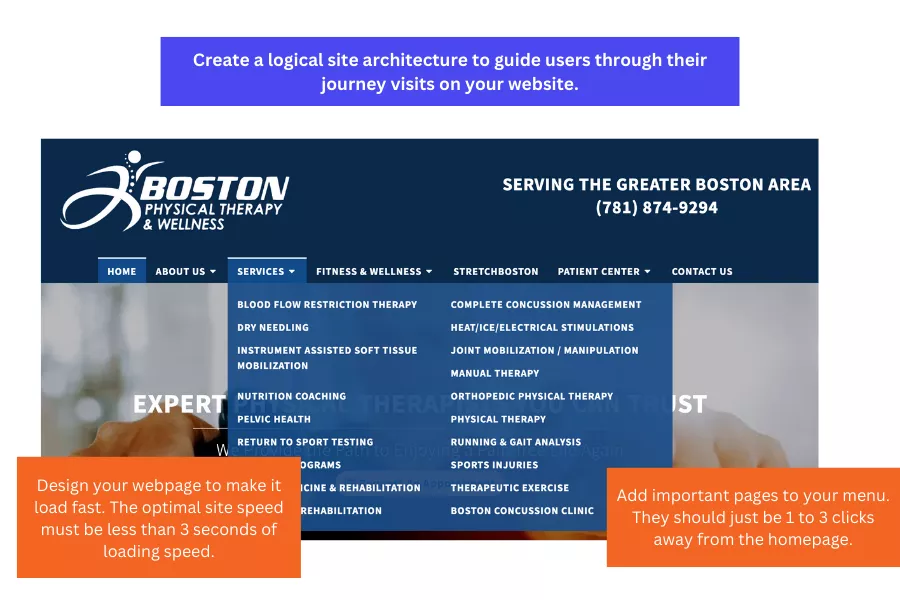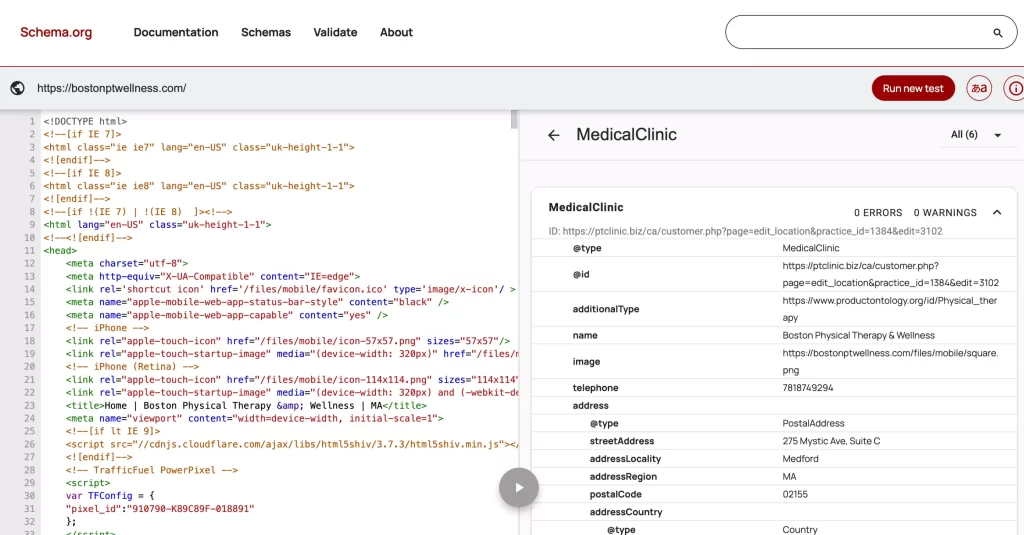by Venchito Tampon Jr | Last Updated on February 20, 2025
Physical therapy SEO presents the best opportunities, as most physical therapy clinics rely on referrals and don’t have much online presence on search.
This means lower competition if you’re doing SEO for physical therapy clinics, making it easy for your physical therapy website to rank higher on Google’s SERPs.
In this guide, I’ll walk through actionable and unique strategies for using physical therapy SEO to attract more patients.
What is Physical Therapy SEO?
Physical Therapy SEO is the process of optimizing a physical therapy clinic’s online presence to rank higher in Google search results—attract local patients and build trust through expertise-driven and patient-centric content, local authority, and hyper-local engagement strategies on Google Business Profiles.
Getting Into the Google Local Pack (Top 3 Map Results)
Google Local Map pack sits above the organic search listings for any physical therapy or treatment keywords.
So, the first SEO activity you need to do is optimize your Google Business Profile and reach the top 3 map results as quickly as possible.
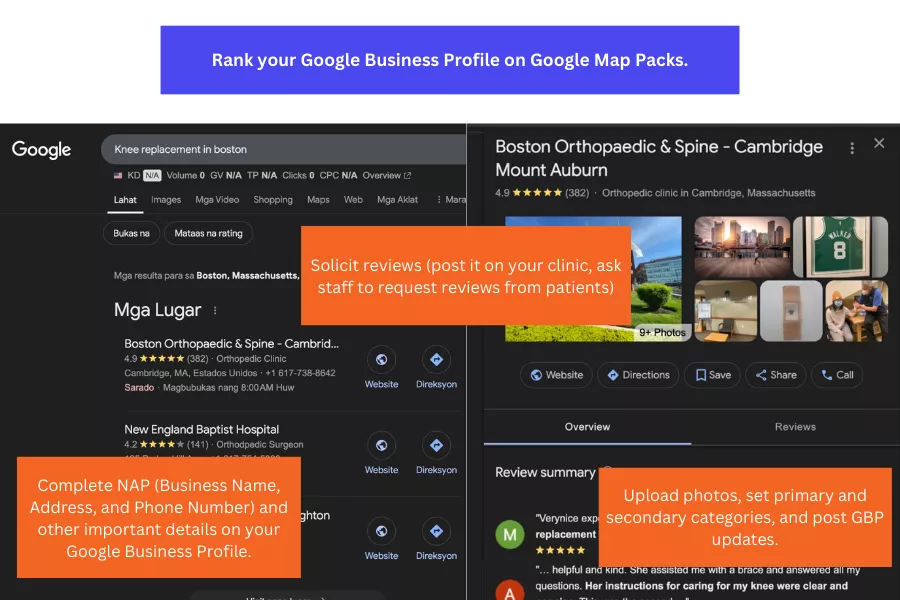
Start by claiming and verifying your Google Business Profile.
Then, once you have it, optimize your GBP by completing all the required information. Essential tips on Google Business Profile optimization include:
- Set “physical therapist” as the primary business category.
- Add complete NAP (Business Name, Address, and Phone Number), consistent with business details included on your website.
- Add appointment links so patients can easily book their slots in your clinic.
- Upload high-quality photos of your clinic, therapists, and treatment rooms.
- Post weekly health tips, promotions, announcements, or clinic news updates. The more frequently you update posts, the more rich signals it sends to Google for your Google Business Profile.
- Encourage reviews by asking satisfied patients to leave a Google review after every session (you can incentivize them to increase the odds of getting legitimate reviews). Solicit reviews as many as you can.
- Respond to all reviews to show engagement and brand credibility.
- Get citations and directory links. Make sure NAP is accurate and consistent with the information on your Google Business Profile. Avoid duplicate or incorrect listings.
Apply all these physical therapy SEO tips, and you’ll undoubtedly rank for your Google Business Profile.
Location Page Optimization
Most physical therapy clinics that want to optimize their websites for search have more than 3 locations, some even having 120+ clinics.
That said, location page optimization is important in optimizing the physical therapy website, as most patients land on these individual location pages to decide whether to book an appointment or go straight to the nearest clinic.
Create dedicated location pages that don’t simply list clinics’ addresses but are well-optimized to target city-specific and micro-location searches.
Optimizing a service page for other industries is really no different, but there are a couple of new items you should highly prioritize adding to the location page.
Apply Basic On-Page SEO
Optimize the URL for the keyword you’re targeting so that Google can better understand the page’s relevance for that local or geographical area.
✅ Best Practice: yourclinic.com/physical-therapy-los-angeles/
✅ For Micro-Locations: yourclinic.com/physical-therapy-downtown-los-angeles/
❌ Avoid: yourclinic.com/locations/ or yourclinic.com/la-clinic/
Optimize the URL for the keyword you’re targeting so that Google can better understand the page’s relevance for that local or geographical area.
The next optimization is your location page title for better relevance signals and meta description for clicks.
Example Title: “Top Physical Therapy Clinic in Los Angeles | Sports Rehab & Pain Relief”
Example Meta Description: “Looking for expert physical therapy in Los Angeles? We offer pain relief, sports rehab, and post-surgery recovery therapy. Call today to book an appointment.”
To your location page, include the service or specific treatment (“physical therapy”) and city name as your target keyword, like “physical therapy in Los Angeles.”
Next is to write unique, location-specific content on the location page. It should contain key details like:
- Services you offered at that location
- Parking and public transportation details (to help patients locate your clinic quickly)
- Nearby landmarks (e.g., “We’re located next to Los Angeles Memorial Coliseum”).
- Staff bios should show enough credibility and trust (e.g., “Our lead therapist, Dr. John Doe, has over 15 years of experience treating ACL injuries and lower back pain.”).
Add more content to your location page by using localized headers (H1, H2, H3 tags).
Good examples of subheadings are:
- “Why Choose Our Physical Therapy Clinic in Los Angeles?”
- “Our Los Angeles Clinic Services: Sports Rehab, Pain Relief & More”
- “How to Find Our Physical Therapy Clinic Near Downtown LA”
Embed Google Maps for Local SEO
One overlooked optimization element in physical therapy SEO is embedding Google Maps on location pages. It strengthens your local SEO by confirming location data to Google. It also increases user engagement so that patients can get directions instantly.
Include Patient Testimonials
If you’ve been operating your clinics for a while and are asking for patient testimonials, including them on your location page makes more sense to build more trust with prospective clients. It’s a social proof that helps increase your location pages’ conversion rates.
Strategic Internal Linking for Nearby Locations
Strategic internal linking is a powerful free SEO technique that can increase user engagement by helping users easily navigate your website.
For location pages in particular, it helps your patients see very close locations, such as neighboring towns or districts, so they can select the nearest, most relevant clinic to visit.
Here are a couple of tips for smart internal linking for nearby locations:
- Link to closest locations based on geography. For example, if you have locations in Los Angeles, Pasadena, and Glendale, you should interlink Pasadena and Glendale, as they are close. Avoid linking Los Angeles and San Diego locations, as they are too far apart for relevant searches.
- Use contextual anchor texts to guide users. Instead of generic links, use localized phrases like “Our Pasadena clinic is just 10 minutes from Glendale! Click here for more details.”
- If you serve multiple locations within one metro area, consider a regional hub page or location cluster page to group those clinics. For instance, you can create a hub page for “Physical Therapy in Greater Los Angeles” with links to Pasadena, Glendale, and Burbank locations.
By linking internally across webpages, you distribute link equity to other nearby location pages, strengthening location relevance between nearby clinics.
Implement Local Business Schema Markup
Schema markup (also called structured data) is a special type of code that helps Google better understand your website’s content. Implementing a Local Business Schema (“Medical Clinic”)can improve the search capabilities of your location pages, ultimately increasing their individual website rankings.
When properly implemented, schema markup can trigger rich search results (also called rich snippets), which makes your location page stand out in Google lists and attract more clicks.
Target Treatment-Specific Keywords (Beyond “Physical Therapy”)
Many physical therapy clinics only optimize for broad terms like “physical therapy in Boston”—while these capture the head keyword you’re trying to rank for, they don’t always match how patients search.
Think of how your patients search. With easy access to knowledge today, they would search for solutions to their specific problems. A few examples are:
- ACL tear recovery exercises
- Post-surgery therapy near me
- Knee replacement exercise program
- Chronic back pain treatment
- Rotator cuff injury treatment
- Sciatica nerve pain relief
- Hip pain therapy without surgery
- Carpal tunnel syndrome treatment
- Whiplash treatment near me
- Work injury therapy program
There is far less competition but more relevant and high conversion intent with these terms for actual clients.
Create dedicated landing pages for each treatment’s specific keywords and place them under your menu of “services,” as appropriate.
Another content writing strategy is to publish a landing page for a broader service and add sections for each treatment service (with internal links pointing to these treatment pages).
Increase Content Library with ‘Symptom-Based Searches’
Not every potential client will go directly to visit your clinic. Most of them are simply searching for information to help them answer their questions. One in particular is about symptoms. Common search likes:
- “Why does my knee hurt when I walk?”
- “Should I see a PT for shoulder pain?”
- “Best way to recover from a sprained ankle?”
These valid questions may or may not require a single blog post to answer, or they are best included in an FAQ section under a relevant treatment service page.
Find all these symptom-based searches using Ahrefs or SEMRush and answer all of them to increase your content library, rank for more long-tail keywords, and get additional patients from people converting to these blog content pieces.
Link Building For Physical Therapy Clinics
Backlinks are a strong ranking factor in Google (and other search engines, too). Not only do they help your physical therapy website improve its search visibility, but they also vote for you as the best solution for the treatment services you’re providing.
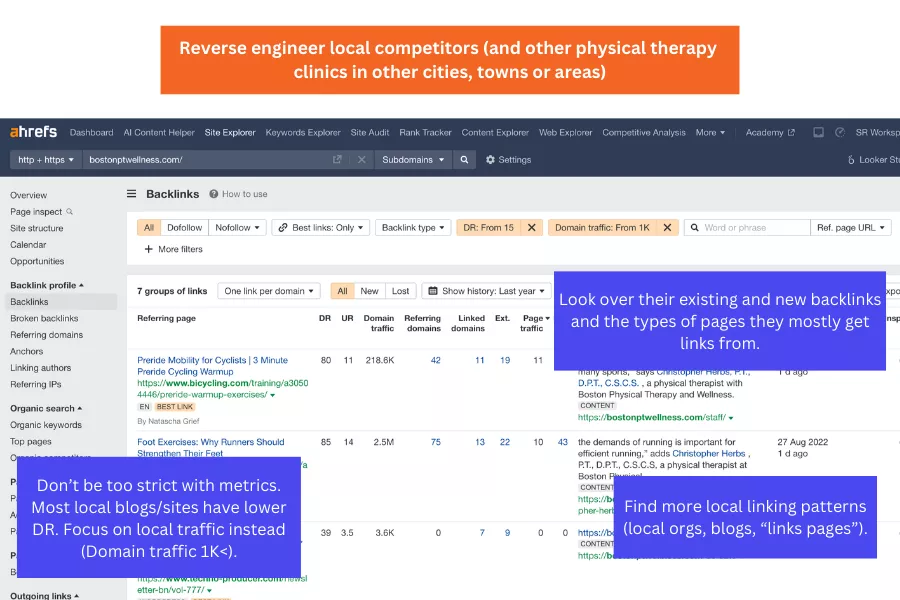
Getting high-quality, highly relevant, trusted, and authoritative editorial backlinks (through strategic link building) is crucial to helping your treatment service pages climb in Google SERPs.
Here are a couple of unique link-building tactics for physical therapy clinics:
- Get listed on local physical therapy directories (but choose legitimate, high-quality niche ones).
- Partner with local healthy bloggers and sports influencers to review your services (you’ll find some of these local content creators on social media).
- Reach out to chiropractors, orthopedists, and local gyms for guest blog or link insertion opportunities.
- Sponsor local events and associations within your area. Through these charity works, most local businesses get featured on local news websites and links pages of local organizations—acquiring them juicy local links.
Check out this guide on local link building to learn more actionable link-building tactics for local businesses.
Create a ‘Pain & Recovery’ Video Series with Patient-Specific Keywords
Getting branded searches and organic social traffic helps improve the search performance of your physical therapy websites.
Aside from optimizing your clinics for search, you can also create engaging videos that target the pain points of your target patients and upload them to YouTube.
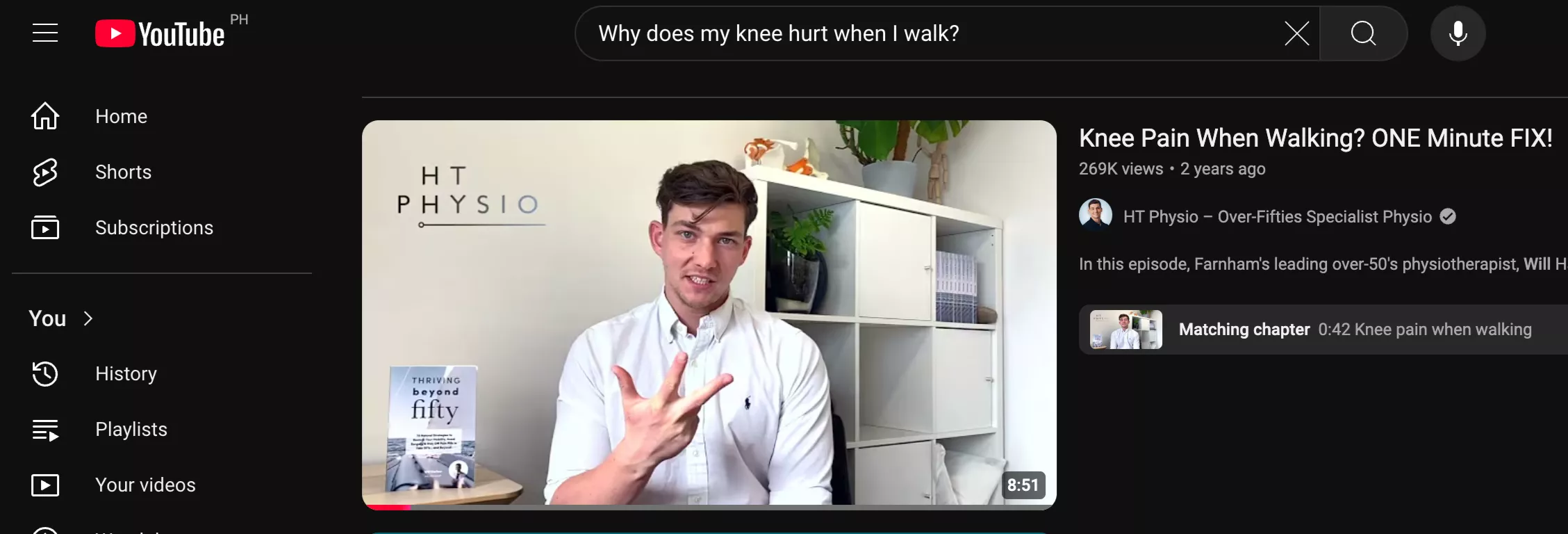
With YouTube as a search engine, you can rank your therapy videos for keyword variants related to your industry.
Going further, you can also do these tips:
- Repurpose video transcripts and turn them into blog posts (making them keyword-rich content).
- Include related YouTube videos to existing articles.
- Post these videos on your Google Business Profile to add update frequency and get more visibility.
Optimize Images for ‘Image SEO’
One way to capture more search traffic is to optimize your images for keywords and get them to rank for image search results—many PT clinics overlook this strategy.
Here’s how to leverage image SEO:
- Rename images with SEO-friendly filenames (e.g., not “IMG_123.jpg” but “physical-therapy-exercises-for-back-pain.jpg”).
- Create before-and-after patient recovery image galleries to show social proof and results of your treatment services—building more trust and engagement with your users.
- Get more backlinks by ranking your physical therapy images (see our image link building guide).
SharpRocket—Agency of Choice for Physical Therapy Clinics
If you need local SEO, full-scale SEO campaigns, or link building services, contact us, and we’ll provide a physical therapy SEO roadmap for you.
The Author
Venchito Tampon Jr
Venchito Tampon is a Filipino Motivational Speaker, Corporate Trainer, and a Leadership Speaker in the Philippines. He is the CEO and Co-Founder of SharpRocket, a link building agency. With a decade of experience, Venchito has a proven track record of leading hundreds of successful SEO (link builidng) campaigns across competitive industries like finance, B2B, legal, and SaaS. His expert advice as a link building expert has been featured in renowned publications such as Semrush, Ahrefs, Huffington Post and Forbes. He is also an international SEO spoken and has delivered talks in SEO Zraz, Asia Pacific Affiliate Summit in Singapore, and Search Marketing Summit in Sydney, Australia. Check out his other businesses, Hills & Valleys Cafe, Blend N Sips and Saas Pursuit.
How our LINK BUILDING AGENCY builds 250 links/mo consistently using Predictable Link Building Methodology™…
- Using a SIMPLE and PROVEN system
- Using a SCALABLE strategy
- No private blog networks
- No creepy outreach emails
